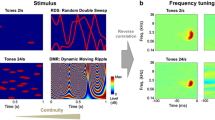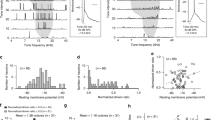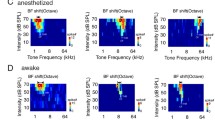Abstract
The effects of nonlinear interactions between different sound frequencies on the responses of neurons in primary auditory cortex (AI) have only been investigated using two-tone paradigms. Here we stimulated with relatively dense, Poisson-distributed trains of tone pips (with frequency ranges spanning five octaves, 16 frequencies /octave, and mean rates of 20 or 120 pips /s), and examined within-frequency (or auto-frequency) and cross-frequency interactions in three types of AI unit responses by computing second-order “Poisson-Wiener” auto- and cross-kernels. Units were classified on the basis of their spectrotemporal receptive fields (STRFs) as “double-peaked”, “single-peaked” or “peak-valley”. Second-order interactions were investigated between the two bands of excitatory frequencies on double-peaked STRFs, between an excitatory band and various non-excitatory bands on single-peaked STRFs, and between an excitatory band and an inhibitory sideband on peak-valley STRFs. We found that auto-frequency interactions (i.e., those within a single excitatory band) were always characterized by a strong depression of (first-order) excitation that decayed with the interstimulus lag up to ∼200 ms. That depression was weaker in cross-frequency compared to auto-frequency interactions for ∼25% of dual-peaked STRFs, evidence of “combination sensitivity” for the two bands. Non-excitatory and inhibitory frequencies (on single-peaked and peak-valley STRFs, respectively) typically weakly depressed the excitatory response at short interstimulus lags (<50 ms), but weakly facilitated it at longer lags (∼50–200 ms). Both the depression and especially the facilitation were stronger for interactions with inhibitory frequencies rather than just non-excitatory ones. Finally, facilitation in single-peaked and peak-valley units decreased with increasing stimulus density. Our results indicate that the strong combination sensitivity and cross-frequency facilitation suggested by previous two-tone-paradigm studies are much less pronounced when using more temporally-dense stimuli.











Similar content being viewed by others
References
Aertsen, A. M. J. H., & Johannesma, P. I. M. (1981). The spectro-temporal receptive field. A functional characteristic of auditory neurons. Biological Cybernetics, 42, 133–143.
Aertsen, A. M. H. J., Johannesma, P. I. M., & Hermes, D. J. (1980). Spectrotemporal receptive fields of auditory neurons in the grassfrog. II. Analysis of the stimulus-event relation for tonal stimuli. Biological Cybernetics, 38, 235–248.
Atencio, C. A., & Schreiner, C. E. (2008). Spectrotemporal processing differences between auditory cortical fast-spiking and regular-spiking neurons. Journal of Neuroscience, 28, 3897–3910.
Atiani, S., Elhilali, M., David, S. V., Fritz, J. B., & Shamma, S. A. (2009). Task difficulty and performance induce diverse adaptive patterns in gain and shape of primary auditory cortical receptive fields. Neuron, 61, 467–480.
Blake, D. T., & Merzenich, M. M. (2002). Changes of AI receptive fields with sound density. Journal of Neurophysiology, 88, 3409–3420.
Britvina, T., & Eggermont, J. J. (2008). Spectrotemporal receptive fields during spindling and non-spindling epochs in cat primary auditory cortex. Neuroscience, 154, 1576–1588.
Brosch, M., & Schreiner, C. E. (1997). Time course of forward masking tuning curves in cat primary auditory cortex. Journal of Neurophysiology, 77, 923–943.
Brosch, M., & Schreiner, C. E. (2000). Sequence sensitivity of neurons in cat primary auditory cortex. Cerebral Cortex, 10, 1155–1167.
Brosch, M., Schulz, A., & Scheich, H. (1999). Processing of sound sequences in macaque auditory cortex: response enhancement. Journal of Neurophysiology, 82, 1542–1559.
Calford, M. B., & Semple, M. N. (1995). Monaural inhibition in cat auditory cortex. Journal of Neurophysiology, 73, 1876–1891.
Christianson, G. B., Sahani, M., & Linden, J. F. (2008). The consequences of response nonlinearities for interpretation of spectrotemporal receptive fields. Journal of Neuroscience, 28, 446–455.
deCharms, R. C., Blake, D. T., & Merzenich, M. M. (1998). Optimizing sound features for cortical neurons. Science, 280, 1439–1444.
Depireux, D. A., Simon, J. Z., Klein, D. J., & Shamma, S. A. (2001). Spectro-temporal response field characterization with dynamic ripples in ferret primary auditory cortex. Journal of Neurophysiology, 85, 1220–1234.
Eggermont, J. J. (1990). The correlative brain; theory and experiment in neural interaction. Berlin: Springer Verlag.
Eggermont, J. J. (2006). Properties of correlated neural activity clusters in cat auditory cortex resemble those of neural assemblies. Journal of Neurophysiology, 96, 746–764.
Eggermont, J. J., Aertsen, A. M., Hermes, D. J., & Johannesma, P. I. (1981). Spectro-temporal characterization of auditory neurons: redundant or necessary. Hearing Research, 5, 109–121.
Eggermont, J. J., Johannesma, P. M., & Aertsen, A. M. (1983). Reverse-correlation methods in auditory research. Q Review Biophysics, 16, 341–414.
Epping, W. J., & Eggermont, J. J. (1986). Sensitivity of neurons in the auditory midbrain of the grassfrog to temporal characteristics of sound. I. Stimulation with acoustic clicks. Hearing Research, 24, 37–54.
Escabí, M. A., & Schreiner, C. E. (2002). Nonlinear spectrotemporal sound analysis by neurons in the auditory midbrain. Journal of Neuroscience, 22, 4114–4131.
Esser, K. H., Condon, C. J., Suga, N., & Kanwal, J. S. (1997). Syntax processing by auditory cortical neurons in the FM-FM area of the mustached bat Pteronotus parnellii. Proceedings of the National Academy of Sciences USA, 94, 14019–14024.
Fitzpatrick, D. C., Kanwal, J. S., Butman, J. A., & Suga, N. (1993). Combination-sensitive neurons in the primary auditory cortex of the mustached bat. Journal of Neuroscience, 13, 931–940.
Fritz, J., Shamma, S., Elhilali, M., & Klein, D. (2003). Rapid task-related plasticity of spectrotemporal receptive fields in primary auditory cortex. Nature Neuroscience, 6, 1216–1223.
Gourévitch, B., Noreña, A., Shaw, G., & Eggermont, J. J. (2009). Spectrotemporal receptive fields in anesthetized cat primary auditory cortex are context dependent. Cerebral Cortex, 19, 1448–1461.
Kadia, S. C., & Wang, X. (2003). Spectral integration in A1 of awake primates: neurons with single- and multipeaked tuning characteristics. Journal of Neurophysiology, 89, 1603–1622.
Klein, D. J., Simon, J. Z., Depireux, D. A., & Shamma, S. A. (2006). Stimulus-invariant processing and spectrotemporal reverse correlation in primary auditory cortex. Journal of Computational Neuroscience, 20, 111–136.
Krausz, H. I. (1975). Identification of nonlinear systems using random impulse train inputs. Biological Cybernetics, 19, 217–230.
Lee, Y. W., & Schetzen, M. (1965). Measurement of the Wiener kernels of a nonlinear system by cross-correlation. International Journal of Control, 2, 237–254.
Marmarelis, V. Z. (2004). Nonlinear dynamic modeling of physiological systems. Hoboken: Wiley.
Marmarelis, P. Z., & Marmarelis, V. Z. (1978). Analysis of physiological systems: the white noise approach. New York: Plenum.
Melssen, W. J., & Epping, W. J. (1992). Selectivity for temporal characteristics of sound and interaural time difference of auditory midbrain neurons in the grassfrog: a system theoretical approach. Hearing Research, 60, 178–198.
Metherate, R., & Ashe, J. H. (1994). Facilitation of an NMDA receptor-mediated EPSP by paired-pulse stimulation in rat neocortex via depression of GABAergic IPSPs. Journal of Physiology (London), 481, 331–348.
Nelken, I., Fishbach, A., Las, L., Ulanovsky, N., & Farkas, D. (2003). Primary auditory cortex of cats: feature detection or something else? Biological Cybernetics, 89, 397–406.
Noreña, A. J., Gourévitch, B., Pienkowski, M., Shaw, G., & Eggermont, J. J. (2008). Increasing spectro-temporal sound density reveals an octave-based organization in cat primary auditory cortex. Journal of Neuroscience, 28, 8885–8896.
Pienkowski, M., & Eggermont, J. J. (2009). Effects of adaptation on spectrotemporal receptive fields in primary auditory cortex. NeuroReport, 20, 1198–1203.
Pienkowski, M., Shaw, G., & Eggermont, J. J. (2009). Wiener–Volterra characterization of neurons in primary auditory cortex using Poisson-distributed impulse train inputs. Journal of Neurophysiology, 101, 3031–3041.
Sen, K., Theunissen, F. E., & Doupe, A. J. (2001). Feature analysis of natural sounds in the songbird auditory forebrain. Journal of Neurophysiology, 86, 1445–1458.
Simon, J. Z., Depireux, D. A., Klein, D. J., Fritz, J. B., & Shamma, S. A. (2007). Temporal symmetry in primary auditory cortex: implications for cortical connectivity. Neural Computation, 19, 583–638.
Steriade, M., Contreras, D., Amzica, F., & Timofeev, I. (1996). Synchronization of fast (30–40 Hz) spontaneous oscillations in intrathalamic and thalamocortical networks. Journal of Neuroscience, 16, 2788–2808.
Suga, N., O’Neill, W. E., & Manabe, T. (1978). Cortical neurons sensitive to particular combination of information-bearing elements of biosonar signals in the mustached bat. Science, 200, 778–781.
Suga, N., O’Neill, W. E., Kujirai, K., & Manabe, T. (1983). Specialization of “combination-sensitive” neurons for processing of complex biosonar signals in the auditory cortex of the mustached bat. Journal of Neurophysiology, 49, 1573–1626.
Sutter, M. L., & Schreiner, C. E. (1991). Physiology and topography of neurons with multipeaked tuning curves in cat primary auditory cortex. Journal of Neurophysiology, 65, 1207–1226.
Theunissen, F. E., Sen, K., & Doupe, A. J. (2000). Spectral-temporal receptive fields of nonlinear auditory neurons obtained using natural sounds. Journal of Neuroscience, 15, 2315–2331.
Valentine, P. A., & Eggermont, J. J. (2004). Stimulus dependence of spectro-temporal receptive fields in cat primary auditory cortex. Hearing Research, 196, 119–133.
Wehr, M., & Zador, A. M. (2005). Synaptic mechanisms of forward suppression in rat auditory cortex. Neuron, 47, 437–445.
Wiener, N. (1958). Nonlinear problems in random theory. New York: Wiley.
Woolley, S. M., Fremouw, T. E., Hsu, A., & Theunissen, F. E. (2005). Tuning for spectro-temporal modulations as a mechanism for auditory discrimination of natural sounds. Nature Neuroscience, 8, 1371–1379.
Woolley, S. M., Gill, P. R., Fremouw, T., & Theunissen, F. E. (2009). Functional groups in the avian auditory system. Journal of Neuroscience, 29, 2780–2793.
Acknowledgements
Arnaud Noreña and Boris Gourévich assisted with the data collection. Greg Shaw provided programming support. This work was supported by the Alberta Heritage Foundation for Medical Research, the National Sciences and Engineering Research Council of Canada, and the Campbell McLaurin Chair for Hearing Deficiencies.
Author information
Authors and Affiliations
Corresponding author
Additional information
Action Editor: Catherine E Carr
Rights and permissions
About this article
Cite this article
Pienkowski, M., Eggermont, J.J. Nonlinear cross-frequency interactions in primary auditory cortex spectrotemporal receptive fields: a Wiener–Volterra analysis. J Comput Neurosci 28, 285–303 (2010). https://doi.org/10.1007/s10827-009-0209-8
Received:
Revised:
Accepted:
Published:
Issue Date:
DOI: https://doi.org/10.1007/s10827-009-0209-8




